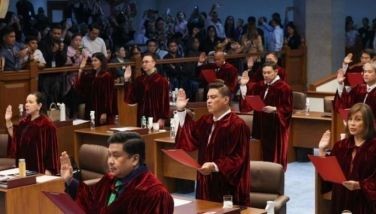End of Days
Today’s readings from Daniel and Mark lead liturgically to the end of the Liturgical year, to next Sunday’s feast, to Christ the King, when the whole of creation will be subjected to the Lord of heaven
and earth, when Jesus Christ will be all in all.Let us look at three aspects of our liturgical assembly today namely: the Church’s liturgy, the word of God, and the needs of the people. So we consider 1) what the Church is celebrating in today’s liturgy; 2) what the Gospel is describing; and 3) how liturgy and Gospel might touch our human and Christian concerns.
First t, the Church’s liturgy. What are we doing here each time we gather? What are we doing today? The problem is, we are such different people that we see different things even in the liturgy.
Someone compared it to the story of four blind men describing an elephant. One said it was a large tree; he had put his arms around the elephant’s leg. “No,” said the second, “it’s a snake with a very coarse skin and a strange, soft mouth”; he had grasped the elephant’strunk. The third swore it was a sail on a ship; he had felt the elephant’s ear. The fourth insisted it was a piece of old rope; he had grabbed the elephant’s tail.
For most of us, the Mass is what we see or would like to see, what we experience or would like to experience. Some suggest that our Mass should return to the time-honored Latin.
Others want more Chinese, more Pilipino Masses. Some want a quiet songless Mass; others want to sing every part of the Mass that can be put into notes; greetings of peace and no peace; communion in the hand or on the tongue, some even want to receive communion kneeling down. The problem is, everyone thinks that his or hers should be the proper way to celebrate the liturgy.
For all their importance, these can be blind spots. They can keep us from seeing more deeply into the mystery we all cherish.
In the liturgy we celebrate the ceaseless work of redemption; we proclaim God’s wonderful works in the history of salvation. We don’t just read about them, we don’t just remember them – we re-present them, make them effectively present in us and in our lives.
In all this, a major element is God’s word. Year after year, the readings repeatedly and endlessly recapture the movement of our salvation.
Last Advent we re-presented the world’s waiting for its Saviour... We welcome the Lord Jesus as he came to us at Christmas, surprisingly in the form of an infant. We grew to manhood with him, walked in his footsteps through Galilee and Judea. We recaptured his dying-rising through Lent and Easter. His Ascension lifted us all with him to the Father; his Spirit descended not only on the disciples but also on each believer.
And since Pentecost we have heard and lived the mission of the Church, its ups and downs, its pride and passion, its agony and its ecstasy, its constant struggle to grow into the fullness of its Lord, its living in hope for the final coming of its Saviour.
And now, we reach the end of the Liturgical year. Next week, the peak – we will crown Christ the King. There the liturgy celebrates what will be the high point of creation, when humankind and all it possesses will be subjected to Christ, “when he delivers the kingdom to God the Father after destroying every rule and every authority and power.”
Today we celebrate the beginning of that end; today we live in anticipation the end of the world, as we know it. If Advent was prologue to the Christian mystery, we sneak a preview into its ending.
Second, the word of God. What is the Gospel describing? In short, three inter-related realities: the end of this world as we know it, the coming of Christ, this time not as a helpless baby but “with great power and glory,” and the assembling into one place of all who are saved.
There is a danger here. In each of these three powerful prophecies you can be misled by images, distracted by the description. The language to which you have listened is the language of the “apocalyptic.” Simply, apocalyptic language was a special style of writing. The writers, having a vision of the final struggle to establish God’s kingdom, used incredibly vivid images, all sorts of symbols, to convey realities beyond their experience. If you have read the Apocalypse, the Book of Revelation, you know what I mean. The images are important, for they suggest the reality; but they are not to be taken with rigid literalism as scientific truths.
So, in today’s Gospel, there is some science fiction – more fiction than science: Sun and moon refusing to shine, stars falling from heaven. This is first century cosmology. These are fascinating images, but do not expect to see the Lord riding in a spectacular pink cloud. And do not be disappointed if you do not encounter real angels flying like superman from Aparri to Jolo.
On the other hand, the Gospel reality is not fiction, not mere imagery. The fact is, this world, the sort of existence we know, this world of war and human wisdom, of sin and self-giving, of laughter mingled with tears, of hunger and plenty – this world will come to an end.
And with it we’ll close the story of salvation here below. All this will end, because it will be time, God’s good time, for Jesus to come in power and glory.
Third, how might today’s liturgy and Gospel touch our human and Christian concerns? To begin with, there are two concerns we can only be curious about: When will the world end, and how?
Is the end of days tomorrow or thousands of years from now? Will it all end in ice or in fire, from God’s action or our own madness?
Despite the books and predictions of the prophets of doom, we simply do not know. Remember what Jesus himself said: “But of that day or that hour no one knows, not even the Son, but only the Father.”
But such ignorance should not immobilize us, or leave us complacent. Whenever and however the world will end, the second coming of Jesus is our eternal hope. For without his second coming his first coming makes no sense.
Since that is so, let us affirm Christ’s final coming with the intensity of the early Christians, who expected him to return in their lifetime.
But if Christ’s coming “with great power and glory” is mostly a matter of Christian hope, if it may well be a millennium or more away, if I can do nothing to hasten or delay it, isn’t it quite irrelevant to my day-to-day existence?
If you are convinced that “Christ will come again,” that the final moment is the moment to which all of history, including your own, is marching, that this is the climax of Christian yearning, then you will live in its light. You will become now what you want to be then.
How do you assure that? The significant single word here is the command of Jesus at the end of this chapter of Mark: “Watch!” Be on the alert! Keep your eyes open!
Watch for what? On the alert for what? Eyes open for what? For the constant coming of Christ into your life. He comes to us all the time: each time you come together; each time His word is proclaimed to you; each time His body rests in your hand or on your tongue. Christ comes to you in each person, man, woman or child, whose eyes meet yours – especially those who hunger for food or love.
My brothers and sisters, it is indeed good to fix your eyes on Christ’s final coming “with great power and glory.” Here, after all, is our Christian hope. But it would be tragic if the far horizon blinded us to Christ’s daily coming in rags and tatters, lonely, frightened, joyless, sick in so many ways, lost in a strange world that does not seem to care. Here, after all, is our Christian love.
- Latest































